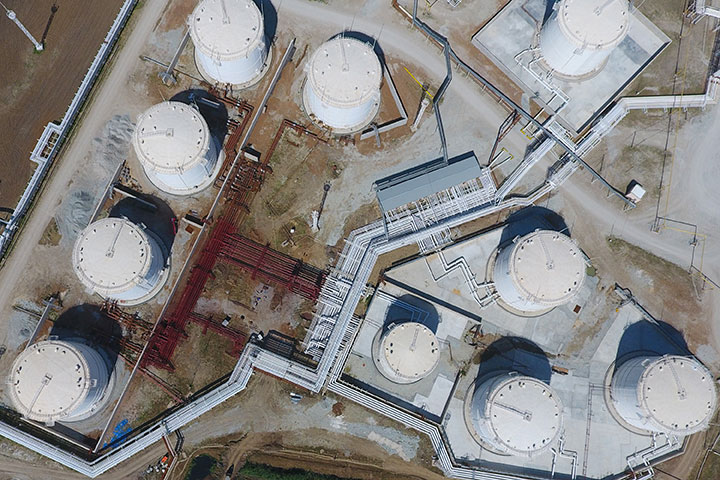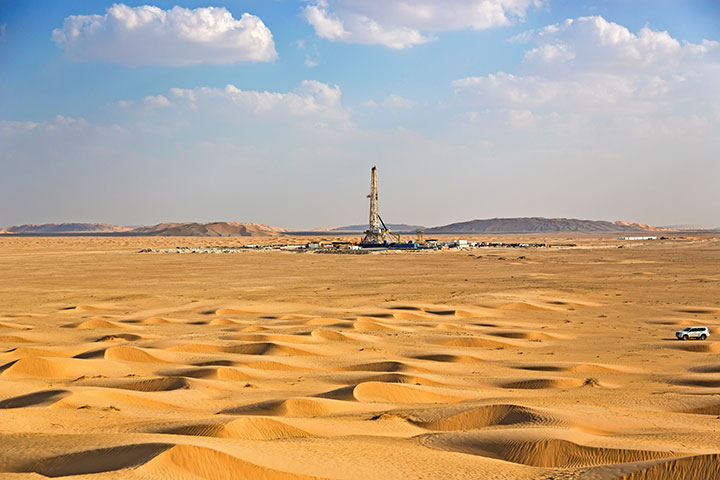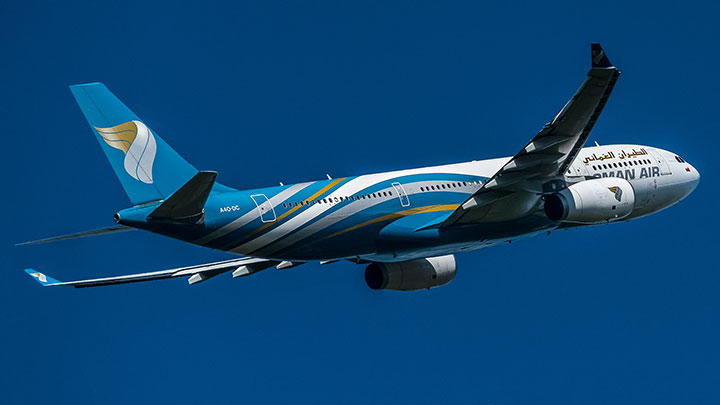 The availability of satellite data and services is helping governments and non-space industries, like the energy sector, meet challenges.
The availability of satellite data and services is helping governments and non-space industries, like the energy sector, meet challenges.
ALEXANDRIA, Va. — Several nations in the Middle East and Africa (MENA) have released strategic visions for space in recent years with a noticeable shift in focus from downstream satellite technology, to developing upstream capabilities, such as sovereign launch, as well as spacecraft design, manufacturing and operations. Still, downstream applications, like data, imagery and various satellite services, are expected to remain the largest source of economic growth in the space sector and will continue to have the greatest bearing on non-space industries and end-users.
Like other parts of the world, leaders in the MENA region see space applications benefitting various industries, such as fishing and agriculture, oil, gas and mining, telecommunications, shipping as well as government functions related to national security, environmental monitoring, border and maritime protection, urban planning and so on.
However, even as space becomes more accessible, it can still be a struggle to demonstrate its value through adoption within non-space sectors.
“The lack of knowledge/awareness of decision makers about the significance and impact of space technology or applications on the wider economy has been the key challenge,” Dr. Saoud Al Shoaili, head of the National Space Program (NSP) within Oman’s Ministry of Transport, Communications and Information Technology (MTCIT) wrote in response to Constellations. “Accordingly, the entire space sector ecosystem hasn’t been nurtured at [the] national level, if we closely compare it to the digital transformation, for example.”
That is beginning to change following Oman’s unveiling of a National Space Policy in February 2023 and a budget allocation to support its goals, which include fostering a domestic space industry and accelerating the development and use of space applications. Oman’s NSP currently works with government agencies to launch sovereign satellites for telecommunications and Earth observation, while collaborating with partners to develop and localize analytic capabilities. “These efforts together will foster and accelerate the development of the space sector,” said Al Shoaili.
While many enterprises will be affected by the growing availability of satellite data and services, the applications for use in commercial aerospace and the energy sector stand out, given their potential to transform such dynamic industries.
Optimizing Oil and Gas Development from Space
While some governments and industries may be unaware of the benefits of satellite and space tech, many are highly attuned to the transformative aspects of space-based applications at the national and enterprise levels.
“Countries are looking to diversify their economy and they see space as a key enabler to facilitate this diversification,” explained Executive Advisor to Euroconsult Steve Bochinger in a Constellations podcast. “They’re using space to solve regional issues and global issues—climate change, disaster management.”
Similarly, sector leaders are also looking to space to solve their problems. This is especially true within the oil and natural gas sector. Petroleum Development Oman (PDO), the country’s leading exploration and production company, has been exploring satellite technology applications for at least the last two decades.
 Governments and industry leaders across the Middle East see the benefits of space technology across sectors, including shipping, energy, telecommunication and others.
Governments and industry leaders across the Middle East see the benefits of space technology across sectors, including shipping, energy, telecommunication and others.
“The use of satellite-based technology has evolved over time and over the years and the resolution has seen quite an improvement to the level that 30cm are now becoming widely available,” said Ahmed Tabook, Geomatic Discipline Lead at PDO. The company first began using 60cm QuickBird satellite imagery around 2003 for seismic data acquisition during site exploration. Today, PDO uses several satellite services and providers, including U.S.-based Maxar, for activities including surface deformation monitoring, urban planning, oil spill detection, pipeline encroachment, greenhouse gas monitoring, terrain and feature classification and object detection.
“Earth observation data has proven its efficiency in minimizing human exposure, HSE [health, safety and environment processes], time consumption and reducing cost,” Tabook said. For example, to improve 3D seismic surveys, PDO utilizes a combination of machine learning techniques with synthetic aperture radar (SAR) satellite data. InSAR techniques have reportedly helped in mapping ground deformation and aiding in the difficult often costly process of enhanced oil recovery.
Satellite-based sensors designed to monitor greenhouse gas emissions are also emerging as a valuable tool in efforts to combat climate change. In December, the King Abdullah Petroleum Studies and Research Center (KAPSARC) in Saudi Arabia released the findings of a study that leveraged satellite technology to estimate the Kingdom’s greenhouse gas emissions related to oil production.
There is also greater attention on satellite technology following the COP28 summit in Abu Dhabi, where dozens of major gas producers announced a pledge to nearly eliminate methane emissions by the end of the decade. It has been acknowledged that ground-based sensors are insufficient to monitor and validate such commitments. Companies that signed onto the agreement include Saudi Arabia’s Aramco, the UAE’s Adnoc, PDO and international oil companies active in the Middle East, like BP, Shell and ExxonMobil.
Always Connected: In-Flight Connectivity and Entertainment
Regionally, the Middle East remains one of the fastest-growing aviation markets in the world. According to Boeing’s latest commercial market outlook, the Middle East fleet will more than double over the next 20 years.
As airlines upgrade their fleets, passengers and carriers are upping their expectations of reliable, high-speed in-flight connectivity (IFC). Alia Al Qalam, Manager of In-flight Entertainment and Connectivity at Oman Air, noted that in today’s digitally connected world, IFC and entertainment “have become an essential part of the cabin experience that delivers airlines’ brand image.” According to the Inmarsat Passenger Experience Survey, 81% of passengers cited in-flight connectivity as important and 83% of passengers said they would rebook with a carrier that offered quality IFC.
“From my perspective, we will continue to see major area[s] of growth for in-flight connectivity in the Middle East/Gulf regions,” said Al Qalam, noting that in the next 5-10 years IFC “would be considered as standard aircraft configuration.”
 The Middle East is expected to be one of the fastest-growing markets for commercial aviation in the coming decades. Fleet upgrades will intersect with customer expectations of in-flight connectivity.
The Middle East is expected to be one of the fastest-growing markets for commercial aviation in the coming decades. Fleet upgrades will intersect with customer expectations of in-flight connectivity.
Oman Air was an early adopter of IFC and became the first in the world to offer a suite of Wi-Fi, text, and mobile telephony on its A330 fleet in 2009. Since then, satellite technology has evolved to better support airline use cases. Al Qalam cited improvements in low-latency, high-throughput capabilities as well as low-profile, low-SWaP electronically steered antennas that are better suited to aircraft. “This for sure will act as a key enabler to airlines to offer seamless connectivity services to their guests onboard,” she said.
According to Euroconsult, revenues for IFC and entertainment services are expected to more than double over the decade. Similarly, commercial aircraft terminals will be the single largest drive of market value for the satellite ground segment.
Still, cost remains a challenge in growing the IFC market. The cost of an average high-throughput Ku-band flat panel antenna for a commercial aircraft is roughly $100,000, not including installation or service contracts. Al Qalam cited high costs, security and “compatibility of space technology with [the] aviation sector” among the biggest challenges for airline carriers seeking to integrate satellite services into operations.
In the future, there are hopes that costs will decrease and advances in technologies, such as satellite 5G non-terrestrial networks (NTN), will result in an improvement of services over what is available currently. According to Al Qalam, with the use of 5G NTN, it “is expected that the quality and speed of in-flight Wi-Fi will significantly improve.”
Leveraging Partnerships While Building Capabilities
Again, many satellite end users in the region continue to rely on partnerships with multinational service providers and satellite operators. Those partnerships will remain critical in the coming period as governments work to develop and augment sovereign satellite systems with commercial capabilities. In the meantime, governments can play a positive role in facilitating relationships that guarantee satellite services for local jurisdictions. For example, in anticipation of the launch of its own satellites, the government of Oman established a company to lease satellite telecommunication capacity to be offered to local users. According to Al Shoaili, Oman’s national survey authority plays a similar role in providing Earth observation resources.
As regional space powers invest more in developing and fielding upstream satellite capabilities, it is possible these dynamics could shift over time. In the meantime, various industries have shown demand for satellite applications and an ability to use those resources to transform their businesses.
Explore More:
Podcast: The Opportunities, Challenges and Future of the Middle East Space Sector
Exploring the MENA Space Sector’s Dynamic Investment Landscape
Down to Earth: How Non-Space Businesses Are Using Space Tech
Satellite IoT Opportunities: Drilling into Oil and Gas
